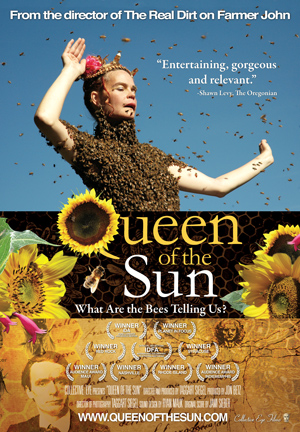- Aperture f/16
- Shutter Speed 1/200 sec
- ISO 100
- NIKON D7000
- Nikkor 105mm f/2.8G ED IF AF-S VR
- Backlit with Nikon SB-800 Flash
- Photo captured in Peter’s Woods Provincial Park, Northumberland County, Ontario
About lowly human parking laws at least!
Yep, a honey bee swarm decided that this parking sign in our department’s parking lot was as good a place as any to settle down for the evening. Lucky for them, the parking authority goes home at 5…
 Confession time: ticks creep me out. So much so, I can vividly remember the first time I saw a tick, and can still feel the near-instantaneous wave of nausea that swept over me…
Confession time: ticks creep me out. So much so, I can vividly remember the first time I saw a tick, and can still feel the near-instantaneous wave of nausea that swept over me…
It was back in high school when I had my first run in with these eight legged freaks. I was working part time at a vet’s office (I was an aspiring vet for most of my childhood, before I took a close look at flies) when a beautiful golden retriever came in with it’s owner, looking all goofy and happy-go-lucky, as pretty much every golden retriever does. The owner had brought her dog in because she found a tick on it’s back and didn’t want to risk breaking it on removal. Being curious, I came around the counter with the vet to have a look at the tiny arthropod which I’d heard so much about, expecting a small spider-like creature perhaps feeding like a mosquito. What I wasn’t expecting was a FULLY ENGORGED, dime-sized tick just pulling out and wobbling along the dog’s back! The vet picked it up in a tissue and passed it to me while he checked the wound on the dog’s back. Nearly in shock from what I had just seen, I peeked within the tissue to get a closer look and confirm that I wasn’t in a nightmare, and lo and behold, there in my hand was a giant, grey mass of nastiness. I managed to maintain an air of professionalism while I walked back around the counter with the tissue, and waited until the customer and her dog (oblivious to the entire process it seems) left before breaking my poker face with a look of utter disgust and revulsion! With a small portion of my curiosity still intact, I decided I’d squeeze the tick to see what would happen; I should have known better, but I maintain that I was in shock and not thinking clearly. With the slightest touch, the tick exploded like a tomato hit by buckshot, leaving the tissue looking like a scene from Texas Chainsaw Massacre, and proving that my gag reflex was still working!
Of course, with the amount of time I spend in the field during the summer, I’ve come close to these little Hellians from time to time, and have seen them sitting at the tip of long grasses, waving their little legs back and forth awaiting an unknowing victim. Needless to say, I always do a quick tick check upon arriving home, and can fully appreciate Brad Paisley’s desire to keep his lady friend safe after a romantic picnic!
Now if you’ll excuse me, I think I can feel my skin crawling…
This song is available on iTunes – Ticks (Radio Edit) – Ticks – Single
Thanks to Marianne Alleyne for reminding me of this song!
It’s been a hot and humid week here in southern Ontario, reminiscent of the jungles of Central and South America! Ok, I might be dreaming a bit there (sigh), but all this hot’n’humid weather has resulted in some wicked storms in the evenings. Tuesday night featured one of the best displays of lightning I’ve ever seen; more than 80,000 lightning flashes were recorded by Environment Canada! After watching the storm passing over for almost an hour, it dawned on me that I should grab my camera and see what I could get out the window. After a bit of trial and error, here’s some of my favourites. Excuse the water droplets, I chickened out and shot through the windows rather than braving the storm outside!
Is it just me or does that last image look like a phylogenetic tree snaking through the sky? Perhaps I’ve spent too much time in the lab lately…
All of these photos were shot with my 18-70 mm lens (at 18mm) on a Nikon D7000 body. I shot wide open (f3.5) and increased my ISO to 500 in order to record as much lightning as possible. As for the shutter speed, I played around with manageable speeds around 1/10 – 1.o seconds long, which wasn’t enough to get a proper exposure. I ended up settling on a 4 second exposure, which gave me plenty of opportunity to capture the random lightning strikes. The downside to such a long exposure? The smallest hand shake can introduce image-ruining blur, so I put both my elbows on the window ledge, controlled my breathing and concentrated on being very still. Of course, I should have used a tripod, but shooting through a window over the kitchen table at 1 am in the dark isn’t a perfect situation, so I made do and got lucky this time. Next time a high powered storm is forecast, I’ll be sure to be better prepared to take advantage!
 We’ve heard it repeated in the media before, with varying degrees of alarmism; honey bees are disappearing, and society better repent before we follow them. Termed Colony Collapse Disorder (CCD) in North America, the number of bee colonies which are dying or exiting en mass (swarming) leaving beekeeper’s hives empty has garnered a great deal of attention in the past few years. Of course there’s plenty of evidence that honey bee populations have been in decline for decades and CCD isn’t really a new phenomenon, but sometimes facts just get in the way of a good story, don’ t they?
We’ve heard it repeated in the media before, with varying degrees of alarmism; honey bees are disappearing, and society better repent before we follow them. Termed Colony Collapse Disorder (CCD) in North America, the number of bee colonies which are dying or exiting en mass (swarming) leaving beekeeper’s hives empty has garnered a great deal of attention in the past few years. Of course there’s plenty of evidence that honey bee populations have been in decline for decades and CCD isn’t really a new phenomenon, but sometimes facts just get in the way of a good story, don’ t they?
That’s the way I felt after watching the new documentary Queen of the Sun: What Are The Bees Telling Us? – the production team didn’t want to weigh the audience down with actual evidence for theories proposed by featured beekeepers or even some of the “experts”. That’s not to say I didn’t enjoy the film, I did, I just left feeling that so much more could have been done to educate the audience.
The movie starts off with endless acres of almond trees in California and the bees trucked in from around the USA tasked with pollinating this giant monoculture. From here the film gathers the opinions of some of the most eccentric beekeepers I’ve seen (which is saying something, trust me) on why the bees are disappearing, with some input from “experts”. It was the beekeepers which make this movie worth a watch, and while each and every one of them personifies bees more than I’d like (damn my scientific objectivity), and there is a lot of Gaiaism and Druid religious undertones, meeting and watching these beekeepers work was a lot of fun. Whether it was the bee historian/Yogi who tickles his bees with his impressive mustache or the rooftop apiculturists in London, UK & Brooklyn, New York (where in the former city beekeeping is legal and the latter illegal), the filmmakers found some very interesting people who shared a passion for their hobby/trade.
The majority of the theories on what is causing the decline of the bees comes from the beekeepers with notes thrown in from the chosen “experts”. I’m using the term “expert” loosely, mainly because there were virtually no credentials or explanation about what made each person an “expert” on the topic. Some I recognized, like May Berenbaum from University of Illinois or Scott Black of the Xerces Society and trusted their opinions because of my knowledge of their work. Others, I have no clue why they were consulted; a physicist discussing genetically-modified plants transferring modified bacteria genomes to bees, without mention of why a physicist would be involved with this research or what institute she was associated with? Providing further credentials and background for each expert would allow the audience to make an informed decision on the information provided to them.
Overall, Queen of the Sun was an entertaining movie with some beautiful photography and fantastic people. If you’re looking for a movie which celebrates individuality and passion for apiculture, then this is your movie. If you’re looking for a scientific nature documentary, stick to David Attenborough and the BBC!
Today is the birthday of one of the most influential natural science artists; John James Audubon (1785-1851). Known for his illustrations of North American birds in natural settings as well as natural history notes for each, Audubon influenced many generations of naturalists, including Charles Darwin. My grandparents hung two large reproductions of plates from his Birds of America series in our family cottage, and they are some of my earliest memories regarding art.
As an homage to John James Audubon, I thought I’d share a photo of the American Kestrel.

American Kestrel - Falco sparverius
Audubon included this species in his account, and it’s one of my favourite images.
Thanks to John James Audubon there are a lot more people interested in the natural world. If you’ve been inspired by his work, why not make a donation to the National Audubon Society as a birthday present!
Must click – Google’s tribute to Audubon
Happy Winter Solstice! It might not be as exciting as Christmas, but the winter solstice signals the lengthening of days, shortening of nights, and the return of summer and insects. Ya, it might be awhile still, but a guy can dream can’t he?
This year also saw a rare occurrence of a full lunar eclipse occurring on the winter solstice. Does it mean anything? Nope, just a special day for a special occasion. Since the next time these two astrological events coincide is in exactly 84 years on Dec. 21, 2094, it would have been a nice time to do some moon-gazing! Of course if it occured at 3am EST on a cloudy night and you have a committee meeting the next day like I did, you had to settle for photos you took in years past!
This shot was from the lunar eclipse of February 2, 2008 and shot from the middle of a rural road north of Guelph. Getting away from the light pollution of cities is the first step in astrophotography. A tripod, a remote shutter release (or warm mitts to guard against the cold while you press that button) and a hot drink all help to get the shot. Unless you live in Western Africa or the South Pacific, you’ll have to wait until June 2012 to try your hand at photographing the next partial lunar eclipse!
This isn’t an insect you say? You’re right; I’m using this Cedar Waxwing to distract you from the recent lack of posts. I’ve been juggling several pressing issues (thesis writing, ESO business, deadlines for external projects, you know the deal) and the blog has been the ball that got bobbled lately. Don’t worry though, I’ve got a couple of important topics lined up to discuss in the near future! Until then, enjoy this symbol of urban Canadian winters, and check back soon for an examination of Canadian Biodiversity Science!
When you think of the Amazon River and it’s tributaries, what comes to mind? Perhaps parrots flying over head
or capybara feasting along the river.
Maybe you envision a caiman slipping into the water, ready to disappear,
or if you’re really lucky, a jaguar sunning itself along the beach.
But the most common sight on the Madre de Dios and Heath Rivers when I was there?
This beastly boat is a mobile gold processing boat, and not only is it illegal, but it’s one of many polluting these rich waters. With the price of gold sky-rocketing (more than $1300USD/ounce), these boats and the “miners” who work with them stand to make more money than many other careers can hope to make in rural areas. The miners spend hours hauling silt from the river bed onto the boat and sifting it on the large ramp like structure on the left. After sifting, the miners then use liquid mercury (by hand and without proper safety equipment no less) to draw the gold out. The mercury ultimately ends up in the river, where all trophic levels are adversely affected, and fish, mammals and birds begin dying off. Besides the obviously horrible effects of mercury, the increased silt builds up downstream and forests are pillaged for supplies and bushmeat. Is there a solution, or method to deter such destructive techniques? While the gold market remains so lucrative, the allure of a “simple” fortune will continue to draw young men. I don’t have an easy solution, but perhaps once young men start seeing prior workers and residents downriver suffering from acute mercury poisoning, they’ll think twice about taking up the trade (or become smarter about the handling and disposal of these deadly chemicals).
Check out this Washington Post story for more information.
Water is the driving force of all nature
– Leonardo da Vinci
I was raised on the shores of Lake Huron, and spent summer vacations on a northern Ontario lake; I have traversed amazonian rivers, and hiked along mountain streams hunting for insects. At work or at play, water has been a contributing factor in my development as a scientist and as a photographer.